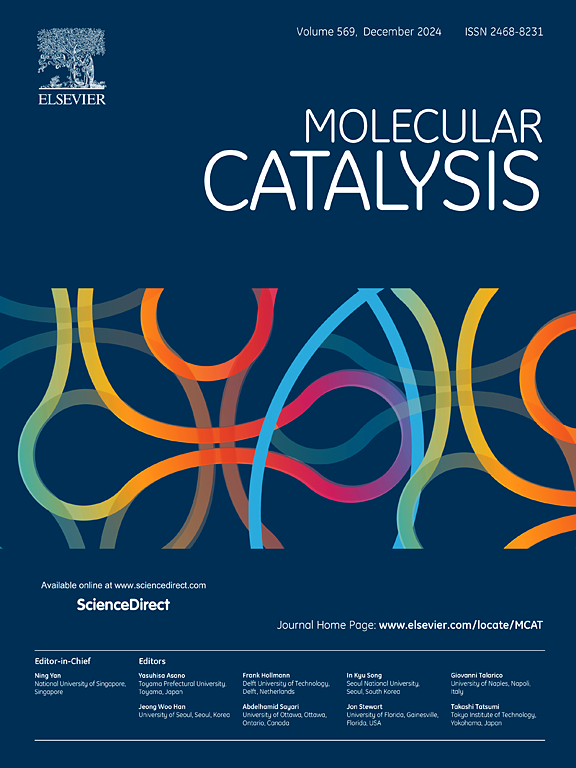On the thermal stability and surface and catalytic properties of Cu-Ni nanoparticles
IF 3.9
2区 化学
Q2 CHEMISTRY, PHYSICAL
引用次数: 0
Abstract
There is an increased interest in nanoparticle research due to the distinct behaviour of nanoparticles and their compact counterparts with the same chemical composition. The distinct properties include different catalytic activities and phase transformation temperatures. The presented paper deals with the thermal stability and surface and catalytic properties of bimetallic Cu-Ni nanoparticles (NPs). Samples with selected compositions of nanoparticles with a diameter of 8 – 21 nm were prepared via the solvothermal method from copper(II) acetylacetonate and nickel(II) acetylacetonate in an organic solvent mixture of oleylamine and octadec-1-ene. The nanoparticles were characterized by dynamic light scattering (DLS), ultraviolet and visible light spectroscopy (UV-VIS), scanning and transmission electron microscopy (SEM, TEM) equipped with elemental analysis using energy dispersive X-ray spectroscopy (EDX). The elemental composition was characterized by inductively coupled plasma optical emission spectroscopy (ICP-OES). The catalytic properties of the Cu-Ni NPs and the catalytic decomposition of the organic envelope were investigated by Knudsen effusion mass spectrometry (KEMS). Carbon dioxide evolution and creation of decomposition products were observed by mass spectrometry (MS). The optimum efficiency of the catalytic process was observed for Cu-Ni NPs with a copper content of 40-50 %. The thermal stability of the Cu-Ni NPs was monitored using differential scanning calorimetry (DSC) and their melting point depression was evaluated to range from 35.9 to 28.4°C. The results include a description of the processes occurring during the heating of nanoparticles above their melting temperature and during cooling. In addition, new findings were made about the catalytic decomposition of the stabilising organic ligands on the Cu-Ni NPs and the solidus curve of the Cu-Ni phase diagram was determined for Cu-Ni NPs of an average size of 12 nm.

Cu-Ni纳米颗粒的热稳定性、表面和催化性能
由于纳米颗粒及其具有相同化学成分的致密对应物的独特行为,人们对纳米颗粒研究的兴趣日益增加。不同的性质包括不同的催化活性和不同的相变温度。本文研究了双金属铜镍纳米颗粒的热稳定性、表面和催化性能。以乙酰丙酮铜(II)和乙酰丙酮镍(II)为原料,在油胺和十八烯的有机溶剂混合物中,采用溶剂热法制备了粒径为8 ~ 21 nm的纳米颗粒样品。通过动态光散射(DLS)、紫外和可见光谱学(UV-VIS)、扫描和透射电子显微镜(SEM, TEM)以及能量色散x射线能谱(EDX)元素分析对纳米颗粒进行了表征。元素组成采用电感耦合等离子体发射光谱(ICP-OES)表征。采用Knudsen液质谱法(KEMS)研究了Cu-Ni NPs的催化性能和对有机包膜的催化分解。用质谱法(MS)观察了分解产物的二氧化碳演化和生成。在铜含量为40 ~ 50%的Cu-Ni NPs中,催化效率最高。采用差示扫描量热法(DSC)监测了Cu-Ni NPs的热稳定性,并评估了它们的熔点下降范围为35.9 ~ 28.4°C。结果包括纳米粒子在其熔化温度以上加热和冷却期间发生的过程的描述。此外,对Cu-Ni NPs上稳定有机配体的催化分解有了新的发现,并确定了平均尺寸为12 nm的Cu-Ni NPs的Cu-Ni相图的固相曲线。
本文章由计算机程序翻译,如有差异,请以英文原文为准。
求助全文
约1分钟内获得全文
求助全文
来源期刊

Molecular Catalysis
Chemical Engineering-Process Chemistry and Technology
CiteScore
6.90
自引率
10.90%
发文量
700
审稿时长
40 days
期刊介绍:
Molecular Catalysis publishes full papers that are original, rigorous, and scholarly contributions examining the molecular and atomic aspects of catalytic activation and reaction mechanisms. The fields covered are:
Heterogeneous catalysis including immobilized molecular catalysts
Homogeneous catalysis including organocatalysis, organometallic catalysis and biocatalysis
Photo- and electrochemistry
Theoretical aspects of catalysis analyzed by computational methods
 求助内容:
求助内容: 应助结果提醒方式:
应助结果提醒方式:


